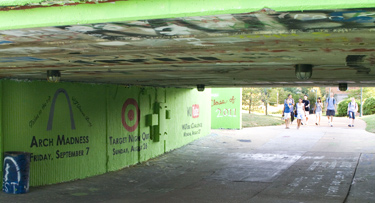After all the goodbyes, all the excitement and all the packing, college life has officially begun. Here you are, in a new home, with new people and a life that will be very different than the one you’ve just left behind. So now what?
Lucky for you, there are plenty of people around to help make your transition a little easier. You’ve hopefully seen your OA’s around campus in the past few days lending a helping hand, because they are here just for you. They are the most visible representation of what the Office of Orientation has been planning for freshmen in the past months. Behind the scenes there are many orientation staff members taking care of all the details to make sure you enjoy your move in to college.
“We’re trying to get [freshmen] to feel comfortable here at Wash. U., [step] out of their comfort zone and live with a diverse group of people,” said Orientation Program Coordinator Dave Brodell, a Wash. U. sophomore. “As a freshman, I realized the importance of freshman orientation and how your first few days as a freshman really mean so much.”
While the Orientation executives have been busy planning events like Club 40, the OA’s have been training to be extra eyes and ears on their floors. OA’s are volunteers who want to pass on their advice and show students what college life at Wash. U. is all about.
“The biggest thing will be to show that we want to be with you guys,” said OA Lauren Brilli, a junior. “We have gone through the same things.”
Sophomore OA Andrew Parker-Klimpel agreed.
“The nature of the beast at large four-year universities is that the people are always changing,” said Parker-Klimpel. “OA’s help keep traditions going and keep [consistency] between years.”
One aspect of Orientation that is changing is the OA program itself. A new goal for this year’s program is to continue OA involvement on freshman floors past the actual Orientation program. Coordinators hope for OA’s to remain connected to their assigned freshmen floors for the duration of the first semester. To help accomplish this goal, the Orientation Office is coordinating efforts with Residential Life.
“It’s important to emphasize that orientation and residential life are a lot closer this year,” said Brodell. “There is much more interaction between RA’s and OA’s.”
Residential Life handles everything regarding the residential colleges, from rooming assignments to the RA’s (Residential Advisors) on every floor. RA’s have similar goals as OA’s, but will be more a part of the long-term transition. Since they actually live on the freshman floors, they will always be around to plan events and answer questions.
“RA’s are trained to be experts of the campus,” said Associate Director of Residential Life Tim Lempfert. “Come to them for anything and everything.”
This includes questions about academics, getting around campus, roommate issues, Wash. U. policies and anything else imaginable. If they can’t answer your question, RA’s are trained to refer you to someone who can.
They are also there to help you interact with your floor.
“One of the number one goals with RA’s is to help build community and form interactions between students,” said Cheryl Stephens, another Residential Life associate director.
The RA’s themselves are eager to help. RA’s are juniors and seniors that are carefully chosen and trained to work with other students. Though their reasons for being RA’s differ slightly, all of them want to help new students to adapt.
Returning RA Taryn Quattrocchi, a senior, wants her freshmen residents to have a first year as great as her own.
“I had a strong positive experience in having a community to rely on,” said Quattrocchi. “I want my freshmen to feel safe and be themselves.”
In contrast, senior Ann Ng wants to use her role as an RA to provide freshman with a better first-year experience than she had.
“I did have a different transition freshman year,” said Ng. “Outside sources helped me, but [this year] I want to create the community that I thought was lacking in my first year.”
If there is ever something an RA can’t handle, they too have a support structure. RA’s are supervised by Residential College Directors, commonly referred to as RCD’s. RCD’s are full time staff members assigned to specific residential colleges. Each RCD lives in his or her residential college and manages everything for the college’s buildings.
Also be aware of faculty resources in each building. Some colleges have faculty fellows, a faculty family that lives in the dorms. All colleges now have faculty associates and you should definitely get to know the one for your floor.
“Faculty associates tie in the academic component of the transition,” said Stephens. “They are a really great way [for] freshmen to connect with faculty.”
It may seem like there are too many acronyms and positions to handle, but don’t be afraid to meet all the people who are here to help you.
“I want freshmen to feel comfortable asking us questions, because we’re not scary upperclassmen,” said RA Shannon Petry, a senior.
If you want an even closer connection to your Res College, Lempfert encourages students to join the Residential College Councils. Just submit a petition for a position and you can have a say in what goes on in your building. Become a floor or assembly representative to let your council know about the issues affecting you and your new floormates.
No matter what your role is in your residential college, make sure you appreciate this unique environment. Don’t be afraid to get out there, ask questions and take advantage of those people who are here to make your experience great.
 Scott Bressler
Scott Bressler Scott Bressler
Scott Bressler



